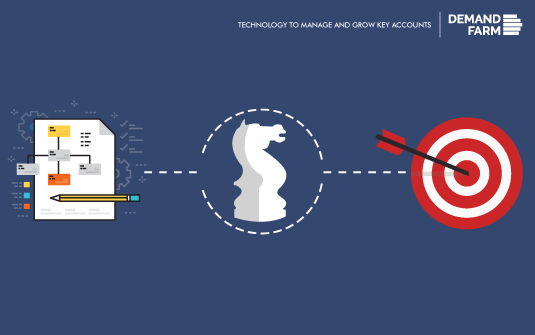The Ultimate Guide to Global Account Management: Framework, Strategies, and Best Practices

In the competitive landscape of international business, there was a company called WorldWideTech. With a strong presence in several countries worldwide, WorldWideTech had made a name for itself as a leading provider of cutting-edge technology solutions. As the company expanded its operations, it had high hopes for continued growth in the global market. However, the path to success was proving to be more challenging than anticipated. The management team quickly realized that they were facing a number of obstacles in their quest for global presence. Among the challenges was gaining visibility into various aspects of their strategic accounts, leveraging best practices from different teams, and institutionalizing processes and systems to ensure smooth operations across their international offices. The situation was beginning to look dire, and the company’s leaders knew that they needed a solution – and fast! This is where Global Account Management (GAM) comes into play. This approach offered a comprehensive framework that would help WorldWideTech tackle its challenges head-on and achieve its growth objectives. Intrigued by the potential benefits, the company’s management team decided to give GAM a try. By adopting a strategic approach, they hoped WorldWideTech would be able to build stronger customer relationships, increase sales, and ultimately strengthen their business. With a clear understanding of their global accounts and customized strategies tailored to each market, they would be able to overcome the challenges of cultural differences and local business practices. This Ultimate Guide to Global Account Management helps with exactly that! It provides the tools and knowledge to take Global Account Management to the next level and unlock your business’s full potential. Read Now: 4 Ways To Optimize Your Global Key Account Management Understanding Global Account Management Embarking on the Global Account Management journey may seem a bit daunting at first! But here’s a breakdown of what it includes, the importance it holds for businesses and an overview of a comprehensive Global Account Management framework. What is Global Account Management? Global Account Management (GAM) is a strategic approach to managing and nurturing relationships with key customers across multiple international markets. It includes the alignment of sales, marketing and customer service efforts to deliver a consistent, tailored experience to global clients. GAM aims to optimize the value generated from these key accounts, fostering long-term partnerships and maximizing profitability by understanding the unique needs of each market and customer. Importance of Global Account Management for Businesses It is crucial for businesses looking to expand into international markets to implement Global Account Management. Here are some reasons why: Sales growth: By nurturing relationships with key global accounts, businesses can capitalize on upselling and cross-selling opportunities, driving revenue growth. Customer retention: Strong account management practices result in improved customer satisfaction, leading to higher customer retention rates and reduced churn. Competitive advantage: Effective GAM strategies allow businesses to anticipate customer needs, stay ahead of market trends, and differentiate themselves from competitors. Streamlined operations: GAM encourages cross-functional collaboration, ensuring that various teams within the organization are working towards common goals. This leads to more efficient operations. Risk mitigation: By understanding the unique needs and preferences of each global market, businesses can better navigate cultural differences and local regulations, mitigating potential risks. Overview of Global Account Management Framework An effective Global Account Management framework is composed of several key components. When these are executed together it results in business success in international markets: Account segmentation: Identify and prioritize key accounts based on criteria like revenue potential, strategic importance and growth opportunities. Account planning: Develop customized plans that outline objectives, strategies, and account items tailored to the unique needs and preferences of each global account. Cross-functional collaboration: Encourage collaboration between sales, marketing, customer service and other departments to ensure excellence in customer experience. Global Account Management Performance metrics: Establish clear metrics to measure the success of your GAM strategies viz. customer satisfaction, revenue growth and customer retention. Cultural adaptation: Train your global account teams to understand cultural differences, navigate language barriers, and be respectful of local business practices. This helps build stronger relationships with international clients. Continuous improvement: Regularly review and adjust your GAM strategies based on performance metrics, feedback and market changes to ensure continued success. Let’s take a look at some important aspects of the Global Account Management framework to ensure that your business thrives in the global arena. Key Components of Global Account Management Framework A strong framework will better help you navigate the world of Global Account Management. This framework serves as the backbone of your international success. It will also help you navigate the many complexities of managing global accounts. Identifying and segmenting global accounts Before diving in headfirst, it’s crucial to identify and segment your global accounts. This process involves recognizing key customers. These are customers that not only show the most potential for revenue and growth but also have strategic importance. By prioritizing these accounts you’ll have a better understanding of how to allocate resources. You can also tailor your approach to each client’s unique needs, ensuring maximum return on investment. Developing account strategies and objectives After your key accounts are identified, you will need to develop customized strategies and objectives for each. This involves understanding the specific needs, preferences and expectations of each global account. Once you have this clarity, craft account plans – outlining objectives, tactics and action items customized to each customer’s requirements. This personalized approach will strengthen customer relationships and enhance customer satisfaction and loyalty. Establishing cross-functional collaboration and communication The success of your Global Account Management efforts relies on cross-functional collaboration and communication, this means ease of information sharing between the various teams involved in managing global accounts. Having regular touchpoints, sharing progress, and discussing challenges ensure that all departments have a clear understanding of what’s going on. They can, therefore, work together to ensure that your global clients always receive the best experience. Measuring and tracking performance metrics Clear performance metrics need to be defined to ensure that your Global Account Management strategies are delivering the desired results. Identify key
Key Account Management Strategy: 4 Successful Account Management Strategies for Account Planning

A major portion of a company’s sales typically come from a small group of customers. Or, as the saying goes, around 80% of a company’s profit will come from 20% of its clients or accounts. We’ve all heard this management adage time and again. However, it continues to hold for many businesses around the world, no matter their size or the industry in which they operate. That’s why it’s critical to have proper strategies in place to ensure you, as a company, manage 20% of your clients with extra care than you normally would. How do you do that? By strategizing and picking the best account management practices for your firm. But despite the best account managers, Key Account Management strategies and approaches are failing. The main reasons behind a failed key account management strategy are a few critical mistakes that organizations tend to make. Those include a misguided selection of key accounts in the first place, overburdening key account managers, and wasting of resources, according to a study by Gartner published earlier this year. By resolving these issues, sales teams can greatly improve their key account growth, the study adds. source: Gartner What is Key Account Planning? Key Account Planning or Strategic Account Planning is a business process that entirely deals with the administration of these strategic key accounts. The best way to administer key accounts is to nurture them into long-term relationships. Key accounts are not just those that are bringing in the most money to your company right now, but can also offer the most promising prospects for growth. The Key Account Management process, in short, involves employing key account managers to maintain, develop and nurture those key accounts, and strategic customer relationships. It requires more in-depth and specialized handling than the role performed by the larger sales team. The popular saying is that in sales, you sell. But when it comes to Key Account Management, you help customers buy. What are the benefits of Account Planning? Key account planning offers a few important benefits for businesses, especially small and medium-sized ones, that make it a must-have. Account Planning is considered one of the most effective ways to both grow revenue and safeguard current sales. In other words, with Account Planning, in one stroke, an organization can protect its present while simultaneously working towards the future. By using Account Planning strategies, your business gains opportunities to cross-sell and upsell additional products or services to existing customers. Can you do this without Account Planning? Perhaps. But it would be a haphazard process. Account Planning ensures that your key account managers or sales reps know exactly which products or services to pitch, and which existing client to pitch it to. As we mentioned above, Account Planning also allows you to protect your existing customer base. It helps curb customer churn. When you use Account Planning strategies, your key account managers and sales rep are armed with the right tools. They can offer personalized solutions to customers who matter. In the process, what occurs is a mutually beneficial transaction between your organization and your key accounts. How do you use key account planning in your business? In the rest of this article, we give you a starting point by examining four best account planning strategies that will benefit your organization. Four Successful Key Account Management Strategies for Account Planning 1. Select the right key accounts How do you identify your key accounts? That should be the first question that comes to your mind, before you can even think about what Key Account Management strategies you need to implement. Key accounts or strategic customers aren’t only the ones that are bringing you the largest chunk of revenue. There are several other parameters that you need to consider before you can designate a client or customer as a key account. Here’s a look at some of those factors you need to consider to arrive at your own list of key accounts or strategic customers: Historic data: How much revenue has an account brought in over the years? How has its ratio of contribution to your company’s profits/revenue expanded (or shrunk) with time? Answering questions like these give you a more accurate and comprehensive description of key accounts in terms of revenue contribution. Growth potential: Now that you have an idea of how much revenue an account has historically contributed to, the next step is to map out its growth potential. How much more can your company earn from an account? Is there enough long-term potential? Do you believe that the organization is financially sound and will remain so for the foreseeable future? Value potential: Does the company offer you opportunities for growth that’s not necessarily based on numbers? For example, does the company have an extensive network or connections that you can tap into? Does it have access to resources you may need, or come with a stellar industry reputation that makes them a value add to your portfolio of customers? Match potential: Of course, it goes without saying that any account you are looking to classify as a key account must be a fit with your own company. For example, the solutions you currently offer (and plan to in future) must, obviously, be a match with what the other organization wants. Often, the culture of a strategic customer also ought to match your own, as it makes it easier to do business with them. As you implement a selection strategy to identify your strategic customers or key accounts, it’s very important to remember not to go overboard. It may be tempting to create a large portfolio of key accounts under the assumption that it boosts your company’s credentials. But the process is meant to be a narrow, selective one. You don’t want to end up with a long list of key accounts that may not be strategic for your company. When you do that, you run the risk of having to remove or demote some accounts, and that can cause unnecessary
The Future of Key Account Management Report – A Global CSO study by DemandFarm

Key Account Management has always been a critical component of every B2B organization, given that in most cases Key Accounts contribute upwards of 60% of their overall revenues. As businesses become more global and complex, the role of strategic account management will evolve further. As companies strive to increase market share and grow their customer base, making a “shift” towards Digital KAM will help them achieve these goals. DemandFarm, with insights from the 2022 CSO Survey conducted across USA, Europe and Asia-Pacific regions gathered 1000+ responses from sales leaders covering the trends, skills, tools, and strategies to understand the future of KAM and its changing landscape. Download the Research Report to uncover the future of KAM and its changing landscape.
Guide: Cross-selling and Upselling Explained

Successful strategies for satisfying the additional needs of customers beyond the primary product and increasing the quantity of the purchase decision. Learn more about how to cross-sell and up-sell in key accounts by understanding customer needs and goals, finding whitespace opportunities, making customized recommendations, and finding the right-person to reach out to deliver the right-message at the right-time. This cheat sheet contains quick tips and strategies on how to successfully cross-sell and up-sell in Key Accounts through focussed conversions, automation, incentives, retargeting, and demos.
Account Planning – A Strategic Approach to Grow Your Key Accounts

What is Account Planning? Account planning is the process of building strategic plans to improve value-driven relationships with your key customers that can help in long-term development and retention, thereby maximizing the revenue potential. Effective account plans help account managers to gain a more in-depth understanding of the client. Account Planning has been around for years. Did you know that 65% of a company’s business comes from existing customers? Or that 80% of your future profits are likely to come from 20% of current customers? In other words, building and cultivating healthy relationships with clients is one of the most effective pathways to exponential growth. With so much at stake, it’s no wonder that 61% of companies consider strategic account management as the key to increasing revenue, profits, and customer satisfaction. While the importance of account management is unquestionable, its implementation leaves a lot to be desired even today. 71% of companies believe that sales improved by less than 26% since launching their Account Management programs. KAM Glossary: Crucial Account Management Terms Explained Why is Account Planning essential for your business to grow? A recent Account Planning Book of Evidence study surveyed 1034 people from 62 countries to determine why organizations undertake the account planning exercise. Most of the results were unsurprising: Better Win rate (75%) Increased understanding of customers’ business (72%) Shorter sales cycles (58%) Better customer loyalty (55%) Increased deal size (49%) Better executive access (47%) Identify non-competitive deals (27%) While this gives us an insight into the benefits of Account Planning as a whole, it also goes to show that there is some ambiguity when it comes to defining the overall purpose of account planning. A better win rate is too vague and can apply to all key account management processes. ‘Increased understanding of customers’ business’ is important but it doesn’t talk about outcomes. Download Now: 9 Steps to Build a Rock-Solid Key Account Management Process Purpose of Account Planning There are a couple of reasons why companies struggle with effective account management. The first is that technological innovation has shifted the landscape across departments and industries, and account management has also changed with it. As a result, companies that weren’t able to keep up with changing trends in account management have suffered. Apart from technology shifts, there is another reason why some companies struggle with effective SAM (Strategic Account Management). The key to effective account management lies in sound Account Planning. Many companies either ignore account planning or do account planning for the sake of it, without a clear understanding of its purpose and expected outcomes. Without effective account planning, account managers are simply unable to create the kind of impression on their clients that they need to. We decided that we needed to get a better understanding of the role of account planning, the technology trends in account management, and the way forward for organizations. Account Planning Template – The Key to Revenue Growth We sat down for an in-depth discussion with Mr. A. Ghosh, Founder, and CEO of Netfotech Solutions. Netfotech is a cutting-edge IT services company that works with clients of all sizes and all across the globe including India, the UK, and Singapore. They also provide many solutions from social e-commerce Solutions, big data consulting, web site development to web hosting, mobile application development, BI & Analytics, and Robotics Process Automation. With such a diverse clientele and a broad range of services, the effective strategic account management plan has emerged as a key growth driver for Netfotech. Here are some key excerpts from our conversation. Mr. Ghosh believes that there are two major reasons to do strategic account planning. Together, they define both the essence and the ultimate purpose of the sales account planning exercise. The first and foremost priority of Account Planning is to ensure that the gross margin in the account is consistent from one year to the next. It’s very easy, especially in a services business, for the cost of client servicing to increase without a corresponding increase in revenue. A detailed account planning template helps to overcome this problem by ensuring that the gross margin stays consistent. Read Now: Account Planning Template – Step by Step Strategic Account Planning The second major reason for Account Planning is to strategically grow the account. Cross-selling and up-selling are some of the easiest ways of maximizing revenue and it is only possible through effective account planning and management. The probability of selling a new service to an existing customer is between 60 to 70% whereas the probability of selling to a new prospect is only 5 to 20%. Together, these two reasons, maintaining profitability and horizontal growth, are the fundamental reason why account planning exists in the first place. In search of an Account Planning Template to grow your Strategic Accounts? Look no further! Overcoming Account Planning Challenges The first step in account planning is an in-depth understanding of the client and their needs. Unfortunately, this is the step at which most account planners falter. If the understanding of the client is superficial, effective account planning is simply not possible. According to Mr. Ghosh, there are three major challenges that most account managers face while trying to get an accurate and comprehensive understanding of their clients. 1. Lack of Ground-Level Intel The devil, as they say, lies in the details. In many cases, account planners simply don’t have access to key strategic information about the client. For instance, a client that is currently using our website development services may soon be looking to get an analytics set-up in place. Unless account managers have access to this kind of strategic information, they may lose an opportunity that is there for the taking. The only way to solve this conundrum is by building closer, more meaningful relationships with clients. 2. Lack of Connection to the Right Stakeholder Sometimes, account managers are unable to get a more comprehensive understanding of the client simply because the person they are in touch with is not
Account Planning Template – Step by Step Guide to Strategic Account Planning

Account Planning Template Existing customers are a critical revenue source for every organization. Meeting growth targets requires sales leaders to build robust strategic account plans and establish well-defined account management processes in the organization and this is where account planning templates come into the picture. Having a customizable template for account planning not only helps retain customers but also enables account teams to identify, develop, and execute growth opportunities within their account base. KAM Glossary: Crucial Account Management Terms Explained What is Account Planning? Account planning is a process of building strategic plans to improve value-driven relationships with key customers that can help in long-term development and retention, thereby maximizing the revenue potential. Effective account plans and templates help account managers gain a more in-depth understanding of the client. The Account Planning Book of Evidence study surveyed 1034 people from 62 countries to determine why organizations undertake the account planning exercise. Most of the results were unsurprising: Better Win rate (75%) Increased understanding of customers’ business (72%) Shorter sales cycles (58%) Better customer loyalty (55%) Increased deal size (49%) Better executive access (47%) Identify non-competitive deals (27%) The Account plan contains critical information about the prospect that every sales rep should know before even thinking about making the initial phone call. Capturing this information down in a concise, structured way helps the salesperson to focus on what is important about the account and how it aligns with your company’s offering. Having a plan can help you go one step further, give you the edge over a competitor, or deliver the crucial piece of data that can close the deal. Simply put, the Strategic Account Plan is the blueprint of the sale. Here, is a template to create quick and effective account plans that help account managers win the game. Account Planning Template 1. Account Overview Documenting the Client’s landscape is important to give a bird’s eye view of their business and general information to the account managers for them to dive deeper. Also, this information must answer all the basic questions about the client like What the client sells, who are their clients, what size are they, where are they located, and much more. 2. Account Segmentation Account Segmentation will help the sales team segment the client accounts into different buckets. This enables the salespeople to come up with the right strategic action planning based on the account positions. You can segment accounts based on the account health score to understand them objectively. 3. Account Financials Understanding the basic financials of the client organization will help identify your potential revenue sources. Also, listing the specific business units and geographic regions of the clients will enable you to know the areas to which you can cater and estimate the Total Annual Revenue potential from the client. 4. Whitespace analysis Whitespace mapping is the virtual representation of data to uncover hidden white space opportunities to target. It helps you to identify the gap between the products/services your customers require vs the products/services you offer. Understanding the pain points at different levels and offering the right solution helps increase revenue from the existing customers. The Sales team can understand current engagements with accounts and explore possible opportunities & whitespaces with the white space analysis. Learn More: Opportunity Planner by DemandFarm boosts tracking capabilities in 65+ opportunities for Dairy MAX 5. Relationship mapping Relationship mapping helps to visualize all the key stakeholders in one place. This mapping tool – org chart software also helps salespeople to explore detailed information about the contacts of the accounts on the budget control, influences they have on each other, etc., You can Know the organizational hierarchy of the accounts to better understand the relationships and the influences between the contacts. 6. Competitor Analysis Competitor Analysis allows you to better understand the market, potential, and behavior of the customers. This analysis with a bunch of data gives a company an advantage over the competitors to grow by developing new market strategies. With competitor analysis, the sales team can also understand the strengths and weaknesses of competitors along with the analysis of customer spend vs wallet share. 7. Communication Planning Capturing all the past interactions between the client and the team will help to sketch the communication pattern that can add value in planning the overall communication strategy. It gives you a year-wise verdict on whether you are in super touch or you need to work more on the volume of meetings. It’s an extremely important exercise to improve your communication strategy to maximize ROI. 8. Account Management KPIs Defining the Account management KPIs is critical to measure the progress of accounts over time, make adjustments in the process & stay on track, solve problems that are in the way, and tackle new opportunities in the accounts. It also helps in analyzing account planning patterns over time. Learn More: 11 Crucial Account Management KPIs that dictate Success Why do you need a Sales Account Planning template? Creating a Strategic Account Management template is not an easy exercise. It can’t be done in an hour before a meeting. So there is a need for a template that can help account managers build quick and effective plans. Most importantly, it gives you a better framework of the data needed to understand the customer. Knowing more about your target and being equipped with insider account knowledge of the account is one of the biggest advantages a salesperson can have. DemandFarm’s Account Management Software DemandFarm’s Key Account Management Software enables dynamic account planning capability natively inside Salesforce CRM and integrates to all other leading CRMS to make account planning ridiculously easy. It helps in achieving a deeper understanding of your Key accounts through improved data visualization and qualitative analysis. Our key account management software empowers companies to visualize, plan, and drive growth in Key Account Sales. Our digital account management experts will be more than happy to guide you. Book a demo today.
Account Planning Tool- A Strategic Investment

Account Planning tools that help you grow revenue Digital transformation has prompted many businesses to invest in account planning tools. Retention, understandably, is a big reason. But, underlying that is also the desire to systematize and institutionalize account planning. Increasing customer retention by just five percent increases profits by 25 to 95 percent – Harvard Business Study. Account Planning is a basic framework for every organization to have a customer-centric approach to increasing customer retention. An Account Planning Template helps in understanding the accounts, analyzing, planning, and delivering the right solution for the right customer. It substitutes the rigorous effort required at the backend and helps you with proper strategic account planning that can be simplified by employing proper account planning tools with advanced features. Is your account planning software missing out on any basic features? Is it causing you to lose any major revenue opportunities? No worries! Account Planning does not have to be stressful! Eliminate account data silos with easy bi-directional sync Explore the essential features below to examine your account planning tool. Account Planning tool within your CRM- To Analyze your Key Accounts 1. Whitespace Analysis Understand current engagements with accounts and explore possible opportunities & whitespaces with the whitespace analysis. Whitespace mapping is the virtual representation of data to uncover hidden white space opportunities to target. It helps you to identify the gap between the products/services your customers require vs the products/services you offer. Understanding the pain points at different levels and offering the right solution helps increase revenue from the existing customers. 2. Relationship Mapping Know the organizational hierarchy of the accounts to better understand the relationships and the influences between the contacts. Relationship mapping helps you visualize all the key stakeholders in one place. This tool enables effortless stakeholder mapping for your key accounts- org chart software also helps salespeople to explore detailed information about the contacts of the accounts on the budget control, influences they have on each other, etc., 3. Communication Matrix Capture all your interactions to sketch the communication pattern which can help in planning a communication strategy. The communication matrix helps you optimize the time for salespeople by giving a trend analysis of the interactions made with the clients. Finding a successful communication pattern and following the same will help close more deals in less time. Account Planning tool within your CRM- To Develop your Business Strategy 1. Account Segmentation Segment accounts based on the account health score to understand them objectively. Account Segmentation will help you segment the client accounts into different buckets based on various attribute scores marked in a graph with account attractiveness across relationship scores. This enables the salespeople to come up with the right strategic account management action plan based on the account positions like Star, Strategic, Streamline and ignore. 2. Competitor Stacking With competitor analysis, understand the strengths and weaknesses of competitors along with the analysis of customer spend vs wallet share. Competitor Analysis allows you to better understand the market, potential, and behavior of the customers. This analysis with a bunch of data gives a company an advantage over the competitors to grow by developing new market strategies. 3. Annual Account Plans Build your account plan with the growth strategy for Buying centers, Engagements, Financials, and Revenue. Annual account plans provide directions for every function in the company to plan their objectives and strategies for the year. Though these strategic account plans are not so elaborated, they help you with insights into the changes to be made in the current structure to drive future growth. Though most companies follow yearly strategic account planning, it must be a continuous process throughout the year to be more effective. Would you like to understand how Account Planning can transform your business? We have cracked the code! Account Planning tool within your CRM- To Track and Govern your Key Accounts Know your progress against yearly plans with a comprehensive account planning tool. A Key Account Management Software gathers real-time data from the CRM and helps you to track multiple parameters to check progress against the plans. Mapping dynamic goals and priorities of the Client to ongoing plans will enable you to make the right strategic calls at the right time. Using Account Planning Tools, Powerful actionable insights can be derived to avoid deviations from the goals. These three account planning & strategy best practices can turn potential clients into key revenue-generating clients. Though Key Account planning is a tough journey, a technology-driven approach with data insights can transform account planning as a whole. So, it’s time to take stock and use the right Account Planning Tools to have a pain-free Account Planning experience.
Strategic Analysis of Key Accounts

A strategic account plan is all about thinking hard and making decisions that have a long-term impact. You don’t make strategic decisions every day. The data and information are available to make these decisions are often limited. It’s the ability of the person to use his/her experience, knowledge and judgment that determines better decisions. This is very complex and person dependent. I believe the right framework could reduce the complexity and help in arriving at better decisions and faster. Management thinkers over the decades have given us certain frameworks to make this strategic thinking easier. Prominent examples that come to my mind are Porter’s Five Forces model & Maslow’s Need Hierarchy. If you observe carefully these frameworks do not give us answers, but help us ask the right questions. Key Account Planning & Management also requires a strategic account management plan and thinking. Key Account Management Software helps you in the process of winning by strategizing ideas, but at least once a year we need to look beyond dollar numbers, relationships, and activities to think about our Key Accounts. I set out to look for frameworks to facilitate this thinking. What I liked most was from the book “Key Account Management-The definitive guide” by Malcolm McDonald & Diana Woodburn. Here are some of the frameworks I would like to use: We would like our engagement with key accounts to be at the strategic level. How do I assess the level of engagement? The level of engagement can be Tactical, Cooperative, Interdependent or Strategic. Ask yourself a set of questions about the key account to know where is the Key Account today. A little math with the right weight to each question and a corresponding answer can tell us the level of engagement. Only knowing the level of engagement is not enough to start taking actions. It must be matched with the account attractiveness and our strength of the relationship in that account. That leads us to the next framework. Strategic: Invest mind-share and ensure profitability Star: Invest time and money. Need not be profitable yet. Status: Maintain the status quo. Streamline: Manage for profitability. Do you know any other frameworks that could help analyzing the key accounts? I would love to know. Because at DemandFarm, we are on a mission to make strategic account planning and management easier and effective with white space mapping.
Listen to this, Key Account Managers!

You may be hearing and seeing a lot of things Key Account Managers, but what most of you need to up your quotient on, is listening. We have heard a lot of talk on listening. But have we started practicing real listening? We have probably not, because, in sales, we are more interested in giving our sales talk, than hearing the customer out. We are focused on one thing – to make sure that whatever we have practiced as a sales pitch should not go unsaid, that we should not be missing out on the important parts. So what is listening? The real meaning of listening is to listen patiently to the customer so that you understand what he is saying or what he is trying to say but is not voicing it. Not all customers or people are explicit or matter-of-fact, when they are talking, you have to learn to ‘read between the lines’ when your customer is talking. This will help you understand him, his perspective, his need; this will help you assess the situation overall. This will help you tailor your pitch to suit the situation and the customer, and we promise; it will be more effective than a ready-made, standard pitch. The unfortunate truth is that, how much ever we talk about listening, it needs to be taught with examples. A daily has quoted that 2% of salespeople are taught ‘listening’ formally. Here are some eye-openers, err, ear openers on listening: We derive 55% of a message’s meaning from the speaker’s facial expressions 38% comes from how he says the message that is his tone of voice and just 7% from the actual words spoken! 50% is how much information we usually recall immediately after we listen to someone talk. We can listen at twice the rate than a person can talk. How to listen and handle a call well. Listen without interrupting – Initiate the conversation and then sit quietly, listening to the customer intently. Acknowledge what is said – Acknowledge what the customer has said. This does not always mean you are in agreement. This just shows that you are listening, which is enough to keep your customer talking. Ask questions – Ask questions to get clarity on what the customer is saying. This way you will learn more than the obvious. Recap and restate – If there is an objection raised, or if it is something the customer is saying, restate it to be on the same page with him and let him know that you are on the same page. Address and overcome – Don’t beat about the bush. Tackle the objection directly by using factual information. For this, you will need to have the product information and the knowledge at your fingertips. Close – Very, very important. Do not leave any loose ends. Close that particular meeting by stating clearly the next steps expected and from whom. Be polite but the state. Move the sale forward in its journey. Correct course, if need be and commit – A sale is never a one-time ‘Hit the bull’s eye’. It takes time. Often, in the journey, the customer will add different inputs that will change the course of your plan. Moreover, will mean that you will have to correct the course, Be patient. Don’t be in a rush to commit just so you can close it. Show your willingness to alter and present again, but with clear timelines specified. I hope these were some handy tips to learn and practice the art of listening and ensuring you engage correctly with your customer and add to the sales effectiveness during every customer interface. God gave us two ears and one mouth for a reason, as it is said. The sooner we practice using our two ears, fully, we get closer to our sales objective. You can also download our whitepaper on the Hype & Art of KAM. P.S- Have you ever wondered, How many Key Account Management professionals are there around the world?


